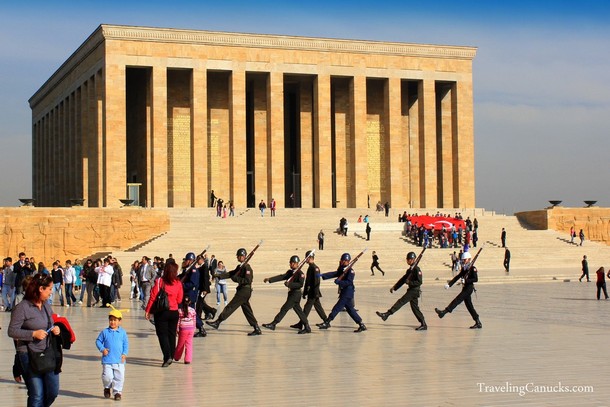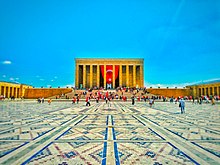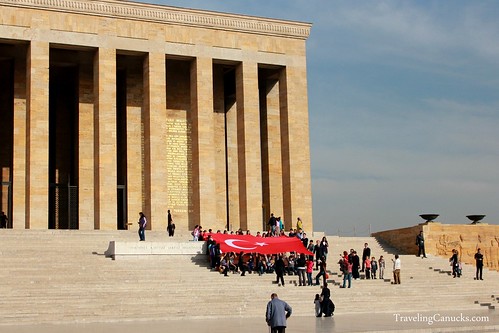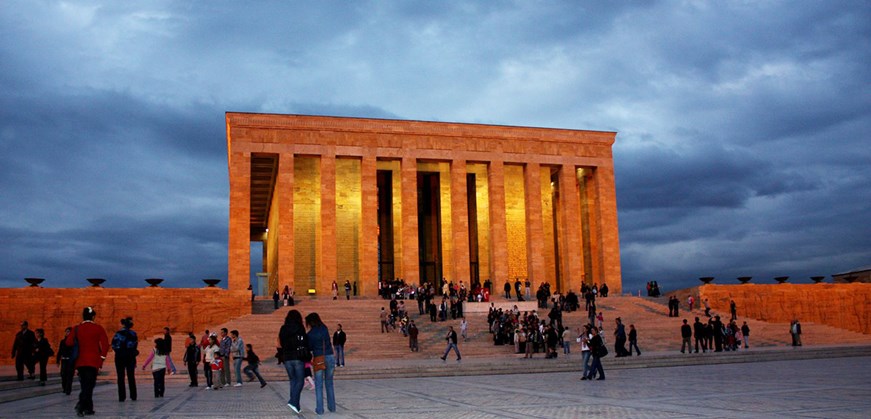Beyond Mausoleum: Explore Ataturk's Spirit in Anitkabir

If you are ever in Turkey, a visit to Ankara would not be complete without a trip to Anitkabir, the mausoleum of Mustafa Kemal Ataturk. As a visitor, you would be impressed by the grandeur of the monument and curious about its history and significance. Let me take you on a tour of this impressive site and the man it commemorates.
Introduction to Ataturk and Anitkabir
As you may know, Mustafa Kemal Ataturk was the founder and first president of the modern Turkish Republic. He was a visionary leader who transformed Turkey from an empire to a secular democracy in the 1920s. Anitkabir is the final resting place of this great leader and is located in the capital city of Ankara. It is a widely recognized symbol of the Turkish nation and attracts thousands of visitors every year. The mausoleum has a ceremonial plaza, a magnificent tomb chamber, and several museums.
History and significance of Anitkabir
Anitkabir was designed by prominent Turkish architects and sculptors in the 1940s and was completed in 1953. The grandeur of the monument reflects the profound respect and admiration that the Turkish people have for their founder and leader. Anitkabir is not just a mausoleum; it is also a historical and cultural museum that showcases the life, achievements, and ideals of Ataturk. In addition to the tomb chamber, the complex houses several museum galleries, a massive library, and an art gallery with exhibitions of Turkish art.
As a visitor, you would be impressed by its grandeur, design, symbolism, and exhibits that reflect the cultural heritage of Turkey. Anitkabir represents the enduring legacy of Ataturk, a leader whose vision and principles continue to shape the identity and aspirations of modern Turkey. A visit to this site is not just an opportunity to pay homage to a great leader but also a chance to immerse yourself in the history and culture of Turkey.
Ataturk's Life Story
Childhood and early education of Ataturk
Mustafa Kemal Ataturk was born in 1881 in the Ottoman Empire's city of Selanik (today known as Thessaloniki in Greece). He grew up in a multicultural neighbourhood of the city and attended a traditional Islamic school before enrolling in a modern secular school. Ataturk was an intelligent and curious student, and his early education laid the foundation for his future leadership.
Ataturk's role in the Turkish War of Independence
Ataturk's most significant contribution to Turkish history was his leadership in the War of Independence (1919-1923). After the Ottoman Empire's collapse, Turkey was occupied by foreign powers, and its unity and sovereignty were at risk. Ataturk's vision and determination inspired the Turkish people to unite and resist the invaders. He organized a national resistance movement, which led to a series of military and diplomatic victories, culminating in the Treaty of Lausanne in 1923.
Ataturk's military prowess and political leadership earned him respect and admiration among his peers and the people of Turkey. His comprehensive reforms transformed Turkey into a modern, secular, and democratic nation-state and established a new national identity. Ataturk's legacy lives on in modern-day Turkey, and his values and ideals inspire people worldwide.
Anitkabir, the mausoleum of Ataturk, is a testament to his leadership, vision, and legacy. A visit to this site is an opportunity to pay homage to a great leader and immerse oneself in the history and culture of Turkey.
Architecture of Anitkabir
History and architecture of Anitkabir
You might feel fortunate enough to visit Anitkabir, the mausoleum of Mustafa Kemal Ataturk, and pay homage to the great leader of Turkey. The site is a testament to his leadership, vision, and legacy and is considered one of Ankara's most iconic landmarks. The construction of Anitkabir began in 1944 and was completed in 1953. It is built on the hill called Rasattepe, which overlooks the city.
Design of the mausoleum
You may be surprised to know that the Anitkabir is not only a mausoleum but also an architectural masterpiece. The mausoleum's design combines traditional Ottoman and modern elements, representing Ataturk's vision of Turkey. The site is divided into three sections: the cerement chamber, the Hall of Honor, and the Peace Park.
The cerement chamber is the central part of the site, where Ataturk's remains are buried. The Hall of Honor is a vast hall with a high domed ceiling that contains Ataturk's belongings, including his library, medals, and photographs. The Peace Park provides a serene and peaceful atmosphere where you can relax and reflect in the mausoleum's gardens, fountains, and ponds.
Anitkabir is a site that symbolizes modern-day Turkey's unity, strength, and identity. You will appreciate the unique blend of traditional and modern architectural design and feel inspired by Ataturk's leadership and vision for a better world. Visiting Anitkabir is a once-in-a-lifetime experience you won't want to miss.

Museum of Ataturk and War of Independence
An overview of the Ataturk and War of Independence Museum
You are privileged to visit the Museum of Ataturk and War of Independence and immerse yourself in Turkey's rich history and culture. The museum was opened in 1981 to commemorate the heroic struggle of the Turkish people during the War of Independence and to honour the legacy of Mustafa Kemal Ataturk, the founding father of modern-day Turkey.
The museum is located in Ankara and spans a vast area, divided into several sections covering different periods of Turkey's history. You can witness Turkey's transformation from an Ottoman Empire to a modern republic, spanning four centuries.
Artifacts and exhibits in the museum
The museum boasts several artefacts and exhibits from the War of Independence and Ataturk's life that showcase Turkey's struggle for freedom and independence. You can see Ataturk's personal belongings, including his military uniform, handwritten letters, and personal items, as well as photographs and paintings depicting Turkey's dramatic transformation.
The museum features several dioramas, models, and interactive displays that provide a detailed look at Turkey's past and present, making the experience informative and engaging. The displays also highlight the significant role played by women and children in the War of Independence.
The Museum of Ataturk and War of Independence is a must-visit site for Turkish history and culture. As you explore the museum, you will likely feel a sense of pride and inspiration as you behold Turkey's history unfolding. Don't miss this opportunity to experience Turkey's unique culture and history.

Ceremonies and Events at Anitkabir
Overview of Ceremonies at Anitkabir
When you visit Anitkabir, you can witness various ceremonies and events that pay homage to the founding father of modern-day Turkey, Mustafa Kemal Ataturk. The most notable ceremony at the mausoleum is the March 18th Martyrs' Day and Canakkale Victory Day, commemorating the victory of the Turkish National War of Independence. The event features a flag-raising ceremony, wreath-laying, and a guard change at the mausoleum.
On November 10th, the country joins in silence every year to honour Ataturk's passing. It is a day of national mourning but also one of renewed commitment to the ideals that Ataturk embodied during his time as Turkey's leader.
Significance of Events at Anitkabir
The ceremonies and events at Anitkabir are more than just a nod to the past. They are a testament to Turkey's present and future.The events remind us that Turkey is a strong and united country, deeply respected and revered for its history and heritage. They also remind us of the crucial role that Mustafa Kemal Ataturk played in shaping the country that we know and love today.
The events and ceremonies at Anitkabir offer visitors a unique opportunity to experience Turkey's vibrant culture and pay respect to its remarkable past. Whether you are a proud Turk or a visitor from another country, you will find something meaningful and inspiring at the mausoleum.
In conclusion, the ceremonies and events at Anitkabir are a testament to Turkey's rich history and unbreakable spirit. We invite you to pay tribute to Mustafa Kemal Ataturk and the ideals he championed during his time as Turkey's leader. So don't miss this chance to be a part of a patriotic and inspiring experience.
Eternal Flame and Ataturk's Crypt
Information about the Eternal Flame
If you can visit Anitkabir, do not miss the opportunity to see the bright eternal flame in honour of Mustafa Kemal Ataturk. The flame is in front of the Ceremonial Plaza and has been burning since 1941 when the mausoleum was completed. The flame symbolises Turkey's strength and resilience and serves as a reminder of Ataturk's unwavering dedication to his country.
Visiting Ataturk's crypt
One of the highlights of Anitkabir is visiting the crypt where Mustafa Kemal Ataturk's sarcophagus is located. Visitors must remove their shoes and wear protective covers over their feet as a sign of respect when entering. Inside, visitors will find a spacious room adorned with marble and delicate carvings. The crypt is located beneath the Ceremonial Plaza and is accessible by stairs or an elevator.
A visit to Anitkabir should include a stop at the Eternal Flame and Ataturk's crypt. These important features of the mausoleum serve as reminders of Ataturk's legacy as a leader and the sacrifices made for Turkey's independence. Don't miss the chance to pay your respects and feel the patriotic spirit of Turkey during your visit.
Garden of Peace
Design and History of the Garden of Peace
If you're looking for a serene and beautiful space to unwind during your visit to Ankara, the Garden of Peace at Anitkabir is the perfect spot. The famous Turkish landscape architect Ali Mimar Sinan Ozyalcin designed the garden. It was opened to the public in 2005 and covers an area of 32,000 square meters. The design is based on incorporating elements of nature and Turkish culture into a peaceful sanctuary.
The garden's centrepiece is a large reflecting pool surrounded by a circular walkway that provides panoramic views of the surrounding area. The pool is filled with lotus flowers, symbolising purity and enlightenment in Turkish culture. The garden is also home to various plants, such as magnolias, saffron crocuses, and cherry trees, which bloom in various seasons throughout the year.
Significance of the Garden of Peace
Apart from its aesthetic appeal, the Garden of Peace is significant because of its symbolic importance. It represents Turkey's peaceful and harmonious coexistence of different cultures and religions. This message is conveyed through various elements, such as the lotus flowers, which represent purity, and the magnolias, which represent resilience. The garden also has a section dedicated to the Turkish War of Independence, reminding visitors of the sacrifices for the nation’s freedom and peace.
The Garden of Peace is not just a beautiful area to relax but also represents the harmony and resilience of Turkey. Its serene environment, coupled with its history and design, makes it a must-visit spot at Anitkabir. When you visit this garden, take a moment to appreciate its significance as a reminder of Turkey's peaceful coexistence of different cultures and religions.

Beyond Anitkabir
Ataturk's legacy and impact on Turkish society
As you continue exploring Ankara beyond Anitkabir, it’s impossible not to encounter the influence of Mustafa Kemal Ataturk, the founder of modern Turkey. Ataturk’s vision for a modern, secular, and democratic nation has impacted Turkish society. His social, political, and economic reforms transformed Turkey into a modern nation and paved the way for a new era of progress and development.
Ataturk’s legacy can be seen in the emphasis on education, women's rights, and the arts. The education system he established aimed to provide equal access to education for all, breaking down the longstanding class barriers in Turkey. Women's rights were also significant to Ataturk's vision for Turkey. He believed in the equality of men and women and gave women equal rights in education, employment, and politics. Furthermore, Ataturk's love for music and the arts led to the creation of institutions dedicated to preserving and promoting Turkish traditional music, dance, and literature.
Monuments and memorials dedicated to Ataturk
Several monuments and memorials are dedicated to Ataturk throughout Ankara, showcasing his significant contributions to the country. The most prominent one is undoubtedly Anitkabir, the mausoleum of Ataturk. Another notable monument is the Ataturk Cultural Center in the city's heart. The centre is a cultural hub, hosting various art exhibitions, concerts, and performances.
The Tandogan Square, located just a few kilometres from Anitkabir, is home to the Monument of the Republic – a large statue of Ataturk on horseback, surrounded by sculptures of Turkish soldiers and civilians. The monument symbolizes the establishment of the Republic of Turkey and the sacrifices made during its creation.
Ataturk's influence can be felt far beyond Anitkabir. His vision and passion continue to shape Turkish society, and his legacy is honoured in several memorials and monuments throughout Ankara. Take a moment to appreciate Ataturk's impact while exploring Ankara's rich history and culture.

Recommendations for visiting Anitkabir
When you visit Anitkabir, make sure to dress respectfully and wear comfortable shoes, as you will be walking on marble floors and stairs. It's best to allocate a few hours for your visit to explore the grandeur and beauty of Anitkabir's architecture and history. You should also check the schedule for the changing of the guard ceremony, a solemn and awe-inspiring event that takes place every day.
Ataturk's legacy is a testimony to his vision, passion, and dedication to building a better Turkey. His impact is evident in the country's history, culture, and way of life. You will discover the richness of Ataturk's legacy as you explore Ankara beyond Anitkabir.
